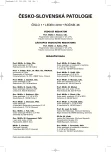The Correlation of Results of Breath Analysers and Laboratory Blood Examinations of Blood-ethanol Concentration (Czech and Slovak Study)
Authors:
M. Hirt 1; T. Vojtíšek 1; M. Zelený 1; J. Krajsa 1; M. Staňková 2; J. Fialka 3; J. Holoubek 3; A. Novotná Rychtecká 3; A. Vlčková 3; A. Pilin 4; P. Ondra 5; P. Hejna 6; J. Mudrová 1; S. Duchaňová 1; K. Zedníková 5; R. Macháček 7; I. Černá 8; E. Krejzlíková 1; I. Válka 5; K. Schneller 1; H. Vaněrková 9; M. Ďatko 1; F. Novomeský 10; Ľ. Straka 11; J. Krajčovič 10; A. Hajtman 11; V. Macko 11; F. Vorel 12
Authors‘ workplace:
Ústav soudního lékařství Lékařské fakulty Masarykovy univerzity a Fakultní nemocnice u sv. Anny, Brno
1; Ústav soudního lékařství Fakultní nemocnice, Ostrava
2; Oddělení soudního lékařství Masarykovy nemocnice, Ústí nad Labem
3; Ústav soudního lékařství a toxikologie Všeobecné Fakultní nemocnice a 1. lékařské fakulty UK, Praha
4; Ústav soudního lékařství a medicínského práva Fakultní nemocnice, Olomouc
5; Ústav soudního lékařství LF UK a FN, Hradec Králové
6; Oddělení soudního lékařství Karlovarské krajské nemocnice a. s., Sokolov
7; Vojenský ústav soudního lékařství Ústřední vojenské nemocnice, Praha – Střešovice
8; Ústav soudního lékařství Fakultní nemocnice Bulovka, Praha
9; Ústav súdneho lekárstva a medicínskych expertíz Jeseniovej lekárskej fakulty Univerzity Komenského, Martin
10; Súdno-lekárske pracovisko Úradu pre dohľad nad zdravotnou starostlivosťou, Martin
11; Soudně-lékařské oddělení Nemocnice, České Budějovice
12
Published in:
Soud Lék., 55, 2010, No. 1, p. 8-9
Overview
The target of this study was to compare the results of breath analysers and “lege artis” laboratory blood examinations when determining alcohol levels. This was then used to determine whether any differences exist between the two methods, and how large thesedifferences are. 610 cases from 11 workplaces in the Czech Republic and Slovakia were analysed. The type of breath analyser was not taken into consideration. All cases had to be in the elimination phase. Difference of time between breath test and blood test were rectified through the use of reverse recomputation. It was detected that only 20.8% of the results of respiratory analyser tests correspond to the detected real alcohol level in blood. The maximum difference when a respiratory analyser measured more than a blood test was 1.34 g.kg‑1 and the maximum difference when theanalyse measured less was 1.86 g.kg-1.
Key words:
ethanol – breath analyser – traffic safety – gas chromatography
Sources
1. Dvořák, M., Wolf, A., Scherm, H., Klír, P., Vaněrková, H.: Postup při zjišťování a hodnocení stupně ovlivnění řidičů motorových vozidel návykovou látkou ve Spolkové republice Německo. Soud. Lék., 54, 2009, No. 4, pp. 56–58.
2. Zikmund J.: Stanovení hladiny alkoholu snadno a rychle [on line]. [cit. 20. 8. 2009]. Dostupné na http://www.zikmund.org/al02.pdf
3. Hirt M., Lacina P., Krejzlík Z., Mráz J.: Ethanol. In: kolektiv autorů: Soudní lékařství. Praha: Grada, 1999, s. 539–537.
Labels
Anatomical pathology Forensic medical examiner ToxicologyArticle was published in
Forensic Medicine

2010 Issue 1
Most read in this issue
- The Correlation of Results of Breath Analysers and Laboratory Blood Examinations of Blood-ethanol Concentration (Czech and Slovak Study)
- An Autopsy case of Poisoning with Selective Serotonin Reuptake Inhibitor, Paroxetine
- Vomitus as a Cause of Fatal Diving Accident of a Commercial Diver
